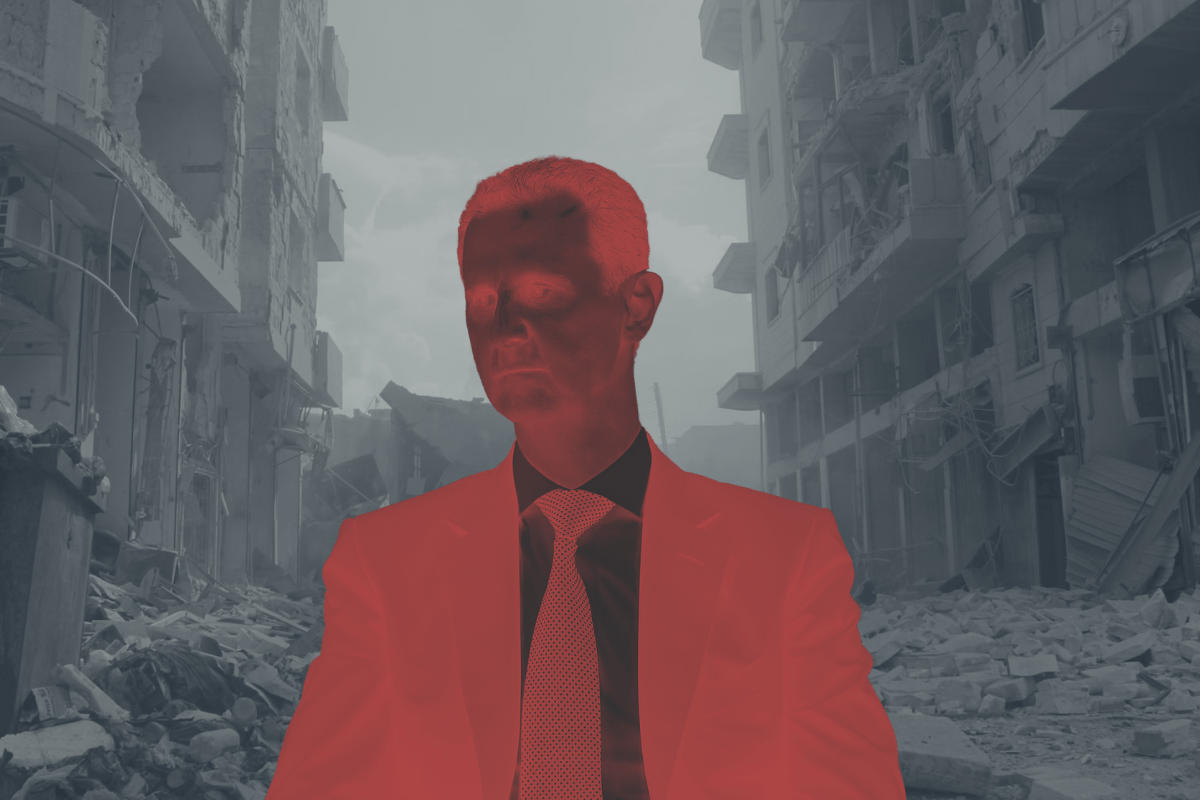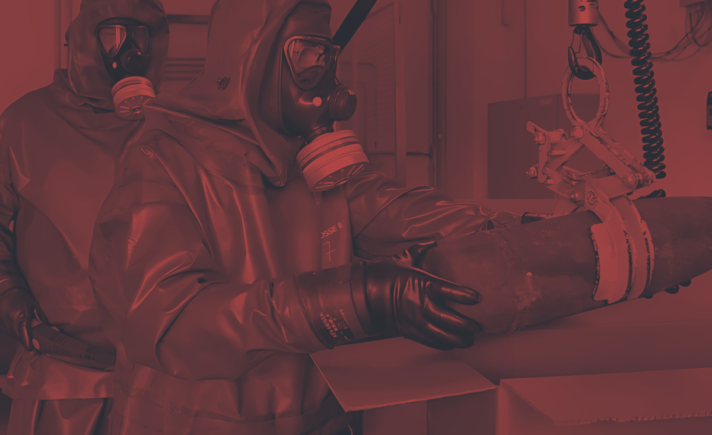On the first of August, 2016, a Russian helicopter crashed near Saraqib, in rural Idlib, resulting in the death of several Russian soldiers. The following night, there were reports of an attack using chlorine gas munitions against Saraqib, and a brutal aerial bombardment campaign which lasted for days and caused dozens of casualties, injuries, and widespread destruction in the city.
Russia did not deny its responsibility for the aerial bombing. Yet, Dmitry Peskov, the spokesman of the Russian president, claimed at the time that any reports of the use of chlorine gas in response to the helicopter crash were completely fabricated.
While neither Russia nor the Syrian regime denied the bombings and destruction that claimed many lives in Saraqib, they continued to deny vehemently the use of chemical weapons. It seemed that unless the world saw hundreds of people die from suffocation by poisonous gas, there was no perceived threat to international peace and security in Syria.
International Decisions Broken
“Decides, in the event of non-compliance with this resolution, including unauthorized transfer of chemical weapons, or any use of chemical weapons by anyone in the Syrian Arab Republic, to impose measures under Chapter VII of the United Nations Charter.”
This is the text of Article 21 of Resolution 2118, and it is how the UN Security Council responded in the aftermath of the 21 August 2013 sarin gas attacks against eastern Ghouta, on the outskirts of Damascus, which claimed more than 1,300 lives.
However, the UN decision seems to have been of no use in deterring the Syrian regime, which continued to use chemical weapons only a few days after the resolution was issued. The difference in subsequent attacks was that they did not use sarin gas, but instead chlorine gas, of which the regime was not required to hand over its stock under the Russian-American agreement (upon which Resolution 2118 was based). This agreement was also the means by which the regime evaded an American military strike, which had seemed imminent after the Ghouta massacre.
Again: “Recalls the decisions made by the Security Council in resolution 2118, and in this context decides in the event of future non-compliance with resolution 2118 to impose measures under Chapter VII of the United Nations Charter.” This is Article 7 of UN Security Council Resolution 2209, adopted on 6 March 2015. The aim of issuing this resolution was to clearly state that the use of all chemical gasses, including chlorine, was also prohibited, but it seemed as if the United Nations wished to correct a simple clerical error that the Syrian regime had fallen into.
This resolution was similarly futile, as Sarmin and Qmenas would face chlorine gas attacks only ten days later, followed by dozens of chemical attacks until today.
Then, a third time, the United Nations Security Council “[r]eaffirms its decision in response to violations of Resolution 2118 to impose measures under Chapter VII of the United Nations Charter.” This is Article 15 of Resolution 2235, issued on 7 August, 2015. The resolution aimed to establish a mechanism to identify those responsible for chemical attacks in Syria, through a joint investigation committee between the United Nations and the Organisation for the Prohibition of Chemical Weapons.
Neither of the two resolutions prior to 2235 had any intention of naming, or even seeking to identify, those responsible for the use of chemical weapons in Syria. Then, after two years of tensions between Russia and the United States, a mechanism to identify those responsible for chemical attacks in Syria was finally approved. It stipulated the formation of a committee of experts by the Security Council that works to identify the parties responsible for the chemical attacks, and then present its findings to the Security Council for discussion.
A third year passed before the investigative committee confirmed, as per that latest resolution, the responsibility of the Syrian regime for the chlorine gas attacks in Talmenes, Sarmin and Qmenas. Russia was quick to question the credibility of the committee’s findings, and after more tenuous negotiations, the committee’s mandate was extended for another year.
As for sarin gas, the Assad regime returned to use nearly four years after the Eastern Ghouta massacre – after four years of successive UN resolutions on the matter. This time it was Khan Sheikhoun that had an encounter with the deadly gas, on the morning of 4 April 2017. This incident was the culmination of the ineffectiveness of all early Security Council resolutions, and prompted a limited American military response (to which we will return later).
The three UN resolutions are therefore not worth the ink with which they were written. The lengthy meetings between the US and Russian foreign ministers, Kerry and Lavrov, were of no use whatsoever in protecting the lives of Syrians. As for whether Kerry and Lavrov were merely wasting their time, the national interests of their respective countries must be considered before making such a claim.
Sarin and Chlorine
Dr. Mohammad Darwish is a pediatrician residing in Eastern Ghouta, who helped treat a number of the victims of the tragic chemical attack in a hospital in the town of Kafr Batna. He had this to say on the matter.
“Sarin gas is an organic phosphate compound. It affects the neuromuscular transmission process, meaning that it causes an imbalance in the functioning of nerves and muscles. This leads to slowing of the heart, narrowing of the pupils, and shortness of breath, followed by muscle spasms, frothing at the mouth, unconsciousness, and death if left untreated. The symptoms of infection are similar to those of inhaling pesticides, and for this reason some doctors had experience in dealing with it, and the available treatment was to inject people with atropine.”
The doctor went on to explain, “Treatment of a victim of sarin gas requires medical staff. There must be a cardiologist and an internal pathologist for each patient at least, in addition to a ventilator and atropine. None of this was available, and there were mistakes in treatment by some paramedics, some of whom were untrained, which compounded the number of victims.”
“As for chlorine gas,” Darwish adds, “it is irritating to the respiratory system and mucous tissues, and is therefore less dangerous (unless inhaled in large concentrated doses), and it is more easily treated. The symptoms that distinguish sarin from chlorine immediately after inhalation are slowing of the heart and narrowing of the pupils of the eyes, while suffocation is a symptom common between the two, which may make the distinction difficult for non-specialists.”
He indicated that since the major chemical attack on Ghouta, “No large-scale chemical attacks have been documented in eastern Ghouta. Rather, there were limited attacks all using chlorine gas. Since August 2013, the people of Ghouta have not been killed by sarin, but they have continued to be killed in the thousands by other weapons.”
It appears evident that sarin gas possesses a deadlier impact than chlorine, and the subsequent developments following Resolution 2118 highlight the crucial significance for the United States in securing the Syrian regime’s commitment to hand over its sarin gas stockpiles and refrain from further use in the Syrian war.
However, in the case of chlorine gas, which can be readily manufactured, the regime did not commit to abstain from its use, with no substantial reaction from any country worldwide. This is despite the issuance of international decisions banning its use in a manner similar to the decision to ban sarin gas, and compelling the regime to relinquish its stockpiles.
Why Use Chlorine Gas Repeatedly?
Returning to Saraqib, there were reports of a chemical attack in April 2013, preceding the major attack on Ghouta and the issuance of Resolution 2118. At the time, it was alleged that a nerve agent was used in the attack. Since then, Saraqib has experienced two additional chemical attacks, reportedly involving chlorine gas. The first occurred on 2 May 2015, following the issuance of Resolution 2209, and the second on 2 August 2016, approximately a year after Resolution 2235.
From the testimonies, it appears that the chemical attacks on Saraqib were limited in scale and did not result in significant casualties. However, there are discrepancies in the eyewitness accounts. Some witnesses claim that both sarin and chlorine gas were used, while others asserted that all attacks used chlorine gas alone. The first attack, widely believed not to have involved the confirmed use of sarin gas, resulted in the death of a woman, even though it occurred on the city’s outskirts. Subsequent attacks with chlorine gas only caused cases of suffocation.
Abdul Hakim Ramadan, a doctor from Saraqib, received some victims of suffocation in the last two attacks. He says, “The chlorine gas used in Saraqib, and in many areas of Idlib countryside, was immeasurably less effective than barrel bombs and cluster and thermobaric munitions in terms of loss of life.” Undoubtedly, chlorine is incomparably less dangerous than sarin as well, but using chemical weapons again caused great terror among the people, as the night raid using chlorine gas in early August caused the immediate displacement of thousands of Saraqib residents.
Chlorine gas, in comparison to more lethal tools of war used by the Syrian regime, is not known to cause significant harm, and its usage has been limited in intensity, resulting in fewer victims. However, the use of chlorine gas has brought international embarrassment to the regime and its major ally, Russia, leading to the issuance of two international resolutions banning its use and threatening retaliatory measures against the offending party. Interestingly, no comparable actions have been taken regarding the use of indiscriminate explosive barrels, which have claimed the lives of thousands of Syrians and are internationally prohibited when used in civilian-populated areas. A mere statement condemning the use of explosive barrels was issued by the Security Council on 5 June 2015, following French pressure.
The sensitivity surrounding the use of chemical weapons may be attributed to the scars left by the First World War, where these weapons, particularly chlorine gas, caused the deaths of hundreds of thousands of people in Europe. This traumatic memory has had a lasting impact on Western nations, restraining them from employing chemical weapons even during the Second World War, despite the destruction of entire European cities through conventional bombs. This historical context seems to influence international policies more profoundly than present-day massacres occurring against others.
Nevertheless, the regime’s decision to use a weapon that brings international embarrassment, especially with binding Security Council resolutions in place, remains perplexing. One possible reason is the terror evoked by chemical weapons, which could weaken the resolve of anti-regime factions’ popular bases. The regime’s usage might also be intended as a message to the opposition, demonstrating its perceived invincibility and signaling that the world lacks the seriousness to prevent it from employing any weapon, including those prohibited by Security Council resolutions. The fact that the regime has previously crossed “red lines” without facing penalties or significant consequences may have emboldened it to push the boundaries further.
The recent chemical attack on Saraqib suggests a third possibility. While Russian and Syrian planes relentlessly bombarded the city, seemingly intent on obliterating it, the international focus centered on investigating a chlorine gas attack that preceded the concentrated “conventional” bombing campaign. This raises the disconcerting notion that the world can become fixated on discussing chemical weapons, even when they result in only thirteen cases of suffocation, while other weapons continue to wreak havoc, causing widespread destruction of cities and mass casualties.
Regardless of the interpretation, one undeniable deduction emerges: the Syrian regime was well aware of the superpowers’ contrasting stances on sarin and chlorine gas – i.e. that the international community was serious in regards to sarin and less serious about chlorine gas – at least until April 2017.
Pushing the Red Lines
Barack Obama left the White House, and with him, of course, John Kerry. Donald Trump, who was said to be a friend of Vladimir Putin, appeared open to cooperating with the Syrian regime on the war on terror. Could this be what prompted the Syrian regime to quickly return to the use of sarin gas? Did Assad think, or was he told, that the only red line that ever was was no longer there? Or did he wish to test it?
Reaching confirmed answers does not seem possible today, but the Syrian regime and its allies trampled over all “red lines” on 4 April 2017, when they attacked Khan Sheikhoun in the southern countryside of Idlib using sarin gas, an attack that resulted in about 100 deaths and hundreds of injuries.
As usual, the Syrian regime and its ally and sponsor, Russia, denied any responsibility for the attack, but the US President, Trump, did not await any investigations, nor did he wait for the United Nations, its committees and meetings, and issued an order to bomb the Shayrat air base from which the plane that bombed Khan Sheikhoun took off. American tomahawk missiles struck the base just two days later.
This is what the seriousness of the great powers looks like; but what seriousness are we talking about?
The Seriousness of the Great Powers
The US strike on the Shayrat base triggered a wave of predictions and analyses, with some speculating that Trump might be resolute in ending the Syrian regime. However, the nature of the military strike itself tells a different story, as the United States informed Russia beforehand, thus reducing the Syrian regime’s losses. It became apparent that the United States had no intention of fundamentally altering its rules of engagement.
Following the strike, the United States refrained from repeating raids against regime forces or their allies, except for instances where convoys of regime forces, Iraqi, and Iranian militias approached areas occupied by American and Western forces in the eastern part of the country. These strikes were aimed at curbing Iranian ambitions in the region rather than holding the Syrian regime accountable for its actions.
Despite extensive talk and commitments by major and regional powers regarding Syria since the onset of its revolution, very little has been faithfully adhered to. Two exceptions are the preservation of “Syrian state institutions” and disarming the Syrian regime of its sarin gas to prevent its use. Regrettably, these commitments did not bring any tangible benefits to the Syrian people, as violence persisted, and the political transition envisioned by the United Nations Charter remained elusive.
The commitment to preserve “Syrian state institutions” and disarm the Syrian regime of sarin gas seemed to serve other purposes. These institutions were empowered to assert “sovereignty and rule of law” and fulfill their “international obligations” to hand over nerve gas stockpiles, the only weapon that could potentially harm regional countries or forces involved in the war on terror.
The meetings between the “friends” John Kerry and Sergey Lavrov regarding the Syrian issue appeared to be experimental and intense, aimed at managing conflicts of influence without direct confrontation or collapse of “state institutions” in conflict zones. The goal was to ensure these institutions would only harm their own people while safeguarding the interests of external actors. This experimental approach has persisted and evolved into the Trump era, when sarin gas and limited strikes by tomahawk missiles became the prominent tools of navigating conflict resolution.








